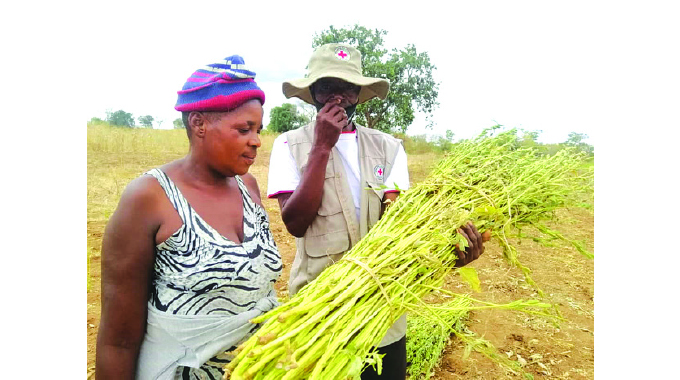Muzarabani farmers struggle for sesame seed market

Phyllis Kachere-Deputy News Editor Convergence
For 42-year-old Mrs Lydia Mudoro of Chareka Village in Muzarabani’s Ward 23 covering the Kaerezi area, growing sesame seeds as an alternative cash crop to her traditional cotton came as a welcome and strategic move.
As a farmer in the drought-prone Kaerezi area, bordering Mozambique on the northern side, Mrs Mudoro has, like generations before her, relied on cotton farming for her family’s cash requirements.
She, with 40 other farmers in Wards 23 and 24 participated in a training for sesame seeds growing facilitated by the Zimbabwe Red Cross Society (ZRCS).
“Having been negatively affected by the non-payment for our delivered cotton by Cottco during the previous cropping season, we grabbed the sesame seeds training by Red Cross as an opportunity to diversify our cash crops,” said Mrs Mudoro during a field tour of the sesame seeds growing project recently.
“I am an active member of the Red Cross branch in our area and we quickly mobilised other community members to join in the training.”
Mr Elias Hwenga, the ZRCS secretary general told The Herald that his organisation sought to enhance sustainability and ensure crop diversity in come generation when they initiated the farming of sesame as a cash crop for volunteers and other community members.
“Sesame is a cash crop whose seeds are rich in oil and is drought tolerant,” said Mr Hwenga.
“It can survive periods of dry weather. Communities in Muzarabani started growing sesame about five years ago, having seen it performing well in nearby Mozambican villages.
“Being a new crop, the farmers had no extension services, hence the Red Cross facilitated training in sesame production through an intensive two-day training in December, 2020 for 20 farmers in Kairezi and Chiwenga.
“Two officers from the Department of Agriculture Extension Services (Agritex) conducted the training.”
Both Kairezi (Ward 23) and Chiwenga (Ward 24) lie along the Zimbabwe-Mozambique border.
Mr Richard Manyere, who is also the Kaerezi Red Cross branch vice secretary, said soon after the training, the volunteers mobilised and lobbied for a piece of land from the village head.
“Through our councillor Alderman Amon Mavedzenge, we lobbied and got a hectare from the village head Mr Ishmael Rudziva for the group to plant our first sesame crop,” he said.
“But the best outcome of the training was that each participant committed to grow their own sesame crop. Almost everyone planted at least a hectare of the crop.”
Like most of the villagers who were trained and have ventured into sesame growing, 17-year-old Crispen Chandiya of Ward 24 in the Chiwenga area now faces the dilemma of finding a market for his thriving crop.
“My family planted one and half hectares of sesame and it has done well,” he said.
“We have not yet completed harvesting it, but we are anticipating between two to two and a half tonnes of sesame seeds.
“Our dilemma now is, who do we sell sesame seeds to?
“We hear GMB has started buying sesame at $70 000 per tonne. With our poor road network here in Chiwenga to the nearest GMB either in Centenary (about 80km) or Muzarabani Growth Point, about 100km, it becomes a nightmare to transport the crop.
“We would prefer a situation where GMB establishes buying points in our ward like what Cottco did for cotton.
“The sad reality is that Mozambican buyers are coming and buying our sesame seeds for next to nothing. Their prices range between US$0,30-$0,50 US per kilogramme. We know, they will sell our crop at higher prices.”
Mozambican-registered haulage trucks are a regular sight along the roads in Chiwenga and Kaerezi as foreign buyers from that country search for sesame seeds from the local farmers.

A Mozambican registered truckt ransports sesame seeds from Chiwenga in Muzarabani. (Inset) is the sesame seed.
“We used to transport our sesame crop into Mozambique in search of more paying buyers, but now the Covid-19 induced lockdown has resulted in borders being closed,” said another grower Mrs Jane Mazonde.
“They (Mozambican border officials) will not allow us in their country. In fact, one may end up being arrested and the crop confiscated.”
The International Trade Centre’s Market Price Information portal shows that the average price of sesame seed in international markets between January to date is US$1,133/tonne.
According to Tridge, a global sourcing hub for food and agriculture, Tanzania buys sesame seeds at US$1365 per tonne while for Pakistan it is US$1452.
Experts say the diverse uses of sesame, from direct consumption as food to an ingredient in cosmetic and pharmaceutical products, makes it a high-value product in regional and international markets.
The Food and Agriculture Organisation (FAO) says the growing world’s population, changing consumption patterns and health awareness of consumers are some of the reasons that has led to a boom in sesame market.
Figures from Trade Map show that global exports of sesame seed in 2019 amounted to US$3,07 billion, up from US$2,7 billion in 2018 and US$2,2 billion in 2017.
Information gleaned from Zimtrade, the national trade development and promotion organisation shows that of these global export figures, Zimbabwe’s share of the export market is a paltry US$85 000.
Zimtrade said increased awareness to consumers on the benefits of sesame seed and support to farmers on production and marketing will enable the more than 1 200 small-scale farmers currently producing sesame to increase production.
As a way of increasing sesame crop growing, Government targeted 100 000 tonnes of sesame crop during the 2020/21 summer farming season through cotton growers and was spearheaded by the Cotton Company (Cottco).
Major global exporters last year were Sudan (US$606 million), India (US$529 million), Ethiopia (US$332 million), Nigeria (US$289 million) and Tanzania (US$189 million).
The largest importers last year were China (US$1.2 billion), Japan (US$303 million), Turkey (US$267 million), India (US$196 million), Korea (US$145 million) and Israel (US$119 million).
As the Kaerezi and Chiwenga sesame crop farmers battle to find a market for their crop, it could be time to turn to Zimtrade, to provide market insights and linking them with potential buyers within the region and beyond.








Comments